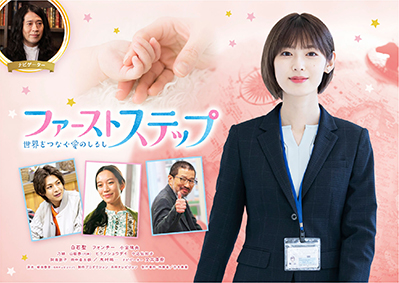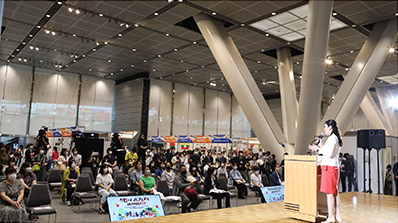2 Efforts for Spreading Awareness of Development Cooperation
(1) Efforts for Information Disclosure and Promoting Public Understanding and Support
The Government of Japan makes various efforts for public relations and information dissemination regarding ODA.
A. Strengthening Public Relations and Information Dissemination

TV drama “The First Step: Sekai wo Tsunagu Ainoshirushi (Japanese only),” set in MOFA’s International Cooperation Bureau and showing scenes of actual international cooperation

Top page of the MOFA’s ODA Twitter account

Parliamentary Vice-Minister for Foreign Affairs Ms. Yoshikawa greeting an audience
In today’s globalized world, Japan and developing countries are in a relationship of supporting each other. Japan’s ODA is of great significance as a critical effort by Japan to contribute to the peace and prosperity of the world, including developing countries, and thereby secure Japan’s national interests. Since ODA is funded by the taxes paid by the people of Japan, it is crucial to communicate the significance and efforts of development cooperation in an easy-to-understand manner, and to gain the understanding and support of a wide range of people in Japan. It is also important that Japan’s efforts be properly understood overseas in order to enhance friendly bilateral relationships and Japan’s credibility in the international community. From these perspectives, ODA public relations become increasingly important.
The Ministry of Foreign Affairs (MOFA) makes efforts for more effective ODA public relations, in cooperation with JICA. MOFA focuses on publicizing its policies, using specific measures to reach young people and small and medium-sized enterprises in rural areas that do not have much contact with ODA. The measures include posts on ODA websites and social media, YouTube videos, ODA email newsletters, ODA-related videos, public relations events, and ODA Delivery Lectures in educational institutions in Japan. One example is “Go! ODA Man,” an animated video series that introduces Japan’s ODA efforts. Other recent examples include a TV drama focused on spreading awareness of the Maternal and Child Health Handbook, featuring TV personality and author Mr. MATAYOSHI Naoki, and streaming a documentary video on the themes of safety and security of marine traffic, and quality infrastructure, with actor Mr. YOSHIHARA Mitsuo as a reporter. These publicity activities intend to communicate respective themes to the public in easier-to-understand and friendlier manners by featuring high-profile performers (see “ODA Topics” for details). In addition, Japanese embassies in developing countries, etc. help local media to cover ODA project sites. Japan’s national flag is displayed on donated equipment or facilities built by Japan to increase the visibility of Japan’s cooperation. Furthermore, ambassadors and Consuls-General of Japan frequently post on Twitter and Instagram by themselves to enhance the understanding of local people about Japan’s ODA.
In the White Paper on Development Cooperation published annually, MOFA works to make its contents easy and fun to read by including many photos and reports from the field, and strives to ensure transparency on the implementation status of ODA by including the relevant statistical data.
JICA also puts efforts into public relations through International Cooperation Delivery Lectures in which ex-Japan Overseas Cooperation Volunteers (JOCVs) share their experiences as lecturers, as well as on-site ODA experience learning for officials of local public entities using its 15 offices across Japan.
As a joint public relations effort not only by MOFA and JICA but also by other parties involved in development cooperation in Japan, MOFA, together with JICA and the Japan NGO Center for International Cooperation (JANIC), holds one of the largest international cooperation events in Japan called “Global Festa JAPAN” every year around the time of International Cooperation Day (October 6). In 2022, in order to facilitate participation from overseas and various areas in Japan, the event was held in a hybrid format both in-person at the Tokyo International Forum and online on Saturday, October 1, and Sunday, October 2, with approximately 22,000 participants, exceeding the previous year.
As a result of these efforts, despite the impact of COVID-19, public response to various public relations tools has steadily increased, as shown by the number of participants in Global Festa JAPAN, the number of ODA Delivery Lectures, and the number of views of posted ODA-related videos. Japan continuously promotes efforts to strengthen public relations even further.
B. Information Disclosure on Implementation and Evaluation of ODA
The Government of Japan set up the “ODA Mieru-ka Site” Note 17 (a website for visualization of ODA) on the JICA website, and posts ODA project summaries, results and ex-ante/ex-post evaluations, and other related information.
Likewise, the MOFA website publishes the results of policy and program level ODA evaluations Note 18 and other related information, in addition to new ODA projects, and statistical materials, in order to promote more effective implementation and public understanding and support for ODA.
C. Promotion of Development Education
MOFA holds the “ODA Delivery Lecture” to explain ODA and other international cooperation at educational institutions, NGOs, and other organizations in Japan. Over the past seven years, a total of 190 ODA Delivery Lectures were held with the participation of approximately 20,000 students and others. JICA also promotes cooperation with ex-JOCVs and local boards of education, and holds International Cooperation Delivery Lectures by JICA trainees staying in Japan. In FY2021, approximately 1,800 lectures were held and attended by approximately 150,000 participants, which exceeded the previous fiscal year. Other efforts to promote understanding and participation in international cooperation include “Visit JICA,” in which students can visit JICA offices in Japan, and the “JICA Essay Contest on International Cooperation for Junior and Senior High School Students.” JICA also runs the exhibition facility “JICA Global Plaza.”
D. Promotion of Discussion and Dialogue
The Government of Japan holds information sessions for NGOs, companies, business associations, and others on how to utilize ODA in respective activities. In addition, the Government of Japan provides opportunities for dialogue with the public interested in diplomacy and ODA, including by holding lectures on international trends and Japan’s efforts in international cooperation.
- Note 17: ODA Mieru-ka Site: https://www.jica.go.jp/oda/ (in Japanese only)
- Note 18: ODA evaluations: https://www.mofa.go.jp/policy/oda/evaluation/index.html
